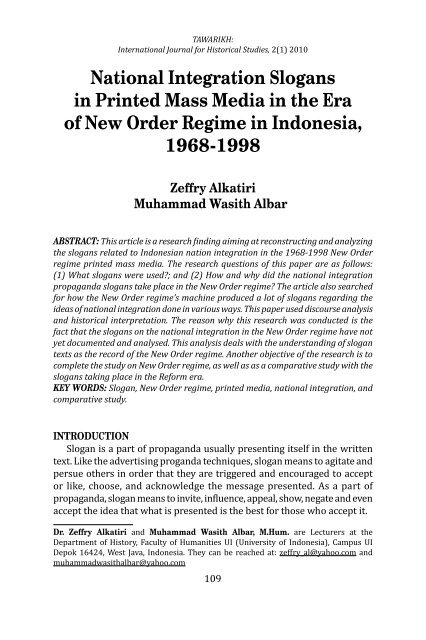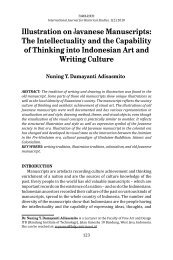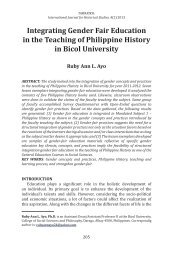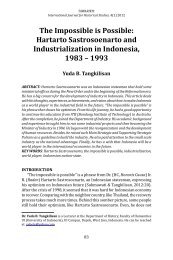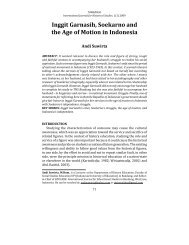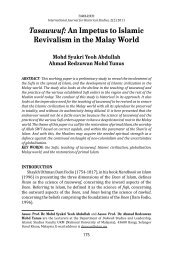National Integration Slogans in Printed Mass ... - Tawarikh Journal
National Integration Slogans in Printed Mass ... - Tawarikh Journal
National Integration Slogans in Printed Mass ... - Tawarikh Journal
Create successful ePaper yourself
Turn your PDF publications into a flip-book with our unique Google optimized e-Paper software.
TAWARIKH:<br />
International <strong>Journal</strong> for Historical Studies, 2(1) 2010<br />
<strong>National</strong> <strong>Integration</strong> <strong>Slogans</strong><br />
<strong>in</strong> Pr<strong>in</strong>ted <strong>Mass</strong> Media <strong>in</strong> the Era<br />
of New Order Regime <strong>in</strong> Indonesia,<br />
1968-1998<br />
Zeffry Alkatiri<br />
Muhammad Wasith Albar 1<br />
ABSTRACT: This article is a research <strong>in</strong>d<strong>in</strong>g aim<strong>in</strong>g at reconstruct<strong>in</strong>g and analyz<strong>in</strong>g<br />
the slogans related to Indonesian nation <strong>in</strong>tegration <strong>in</strong> the 1968-1998 New Order<br />
regime pr<strong>in</strong>ted mass media. The research questions of this paper are as follows:<br />
(1) What slogans were used?; and (2) How and why did the national <strong>in</strong>tegration<br />
propaganda slogans take place <strong>in</strong> the New Order regime? The article also searched<br />
for how the New Order regime’s mach<strong>in</strong>e produced a lot of slogans regard<strong>in</strong>g the<br />
ideas of national <strong>in</strong>tegration done <strong>in</strong> various ways. This paper used discourse analysis<br />
and historical <strong>in</strong>terpretation. The reason why this research was conducted is the<br />
fact that the slogans on the national <strong>in</strong>tegration <strong>in</strong> the New Order regime have not<br />
yet documented and analysed. This analysis deals with the understand<strong>in</strong>g of slogan<br />
texts as the record of the New Order regime. Another objective of the research is to<br />
complete the study on New Order regime, as well as as a comparative study with the<br />
slogans tak<strong>in</strong>g place <strong>in</strong> the Reform era.<br />
KEY WORDS: Slogan, New Order regime, pr<strong>in</strong>ted media, national <strong>in</strong>tegration, and<br />
comparative study.<br />
INTRODUCTION<br />
Slogan is a part of propaganda usually present<strong>in</strong>g itself <strong>in</strong> the written<br />
text. Like the advertis<strong>in</strong>g proganda techniques, slogan means to agitate and<br />
persue others <strong>in</strong> order that they are triggered and encouraged to accept<br />
or like, choose, and acknowledge the message presented. As a part of<br />
propaganda, slogan means to <strong>in</strong>vite, <strong>in</strong>luence, appeal, show, negate and even<br />
accept the idea that what is presented is the best for those who accept it.<br />
Dr. Zeffry Alkatiri and Muhammad Wasith Albar, M.Hum. are Lecturers at the<br />
Department of History, Faculty of Humanities UI (University of Indonesia), Campus UI<br />
Depok 16424, West Java, Indonesia. They can be reached at: zeffry_al@yahoo.com and<br />
muhammadwasithalbar@yahoo.com<br />
109
ZEFFRY ALKATIRI & MUHAMMAD WASITH ALBAR,<br />
<strong>National</strong> <strong>Integration</strong> <strong>Slogans</strong> <strong>in</strong> Pr<strong>in</strong>ted <strong>Mass</strong> Media<br />
Slogan is structurally an effective and eficient tool <strong>in</strong> term of deliver<strong>in</strong>g<br />
certa<strong>in</strong> messages of the sender to the number of the addressees. Slogan<br />
is presented <strong>in</strong> various persuasive and active media and often <strong>in</strong> oblig<strong>in</strong>g<br />
ways to create a situation that everybody has to cont<strong>in</strong>uously listen, see,<br />
and feel the messages of the slogan.<br />
The Orde Baru (New Order) regime <strong>in</strong> Indonesia, therefore, used slogans<br />
to dessim<strong>in</strong>ate, <strong>in</strong>form, <strong>in</strong>tensify, and extend its social policies to the<br />
community, particularly those <strong>in</strong> connection with the national <strong>in</strong>tegration<br />
through its pr<strong>in</strong>ted and electronic mass media under the government<br />
control. Propaganda itself is an aspect of political communication conducted<br />
on the bais of consequence and political impacts, with the objectives of<br />
persuad<strong>in</strong>g others through propaganda as a means of communication<br />
(Jackall, 1995:1-2).<br />
Propaganda generally means to have a one-way communication and<br />
tends to be <strong>in</strong>structional and is a tool systematically designed to emotionally<br />
manipulate certa<strong>in</strong> th<strong>in</strong>gs for the sake of the sender’s <strong>in</strong>terests and this idea<br />
is not that strongly felt by the addressee. Us<strong>in</strong>g its propaganda, the New<br />
Order regime <strong>in</strong>tentionally designed its propagandas <strong>in</strong> various slogans<br />
on the basis of certa<strong>in</strong> selected situations and conditions, <strong>in</strong> particular<br />
those connected to the national <strong>in</strong>tegration problems. Such slogans are<br />
<strong>in</strong>tentionally and cont<strong>in</strong>ually prepared to persuade and <strong>in</strong>luence the<br />
op<strong>in</strong>ions <strong>in</strong> the community, stat<strong>in</strong>g that the New Order regime ran well<br />
and had done its best for the community.<br />
Dan Nimmo and James E. Comb further argues that propaganda<br />
functions as a communication tool used by a certa<strong>in</strong> organized group<br />
of people who <strong>in</strong>tend to create active or passive mass participation<br />
consist<strong>in</strong>g of <strong>in</strong>dividuals united to become an organization (Nimmo &<br />
Comb, 1994:136). This statement is an important idea when connected<br />
to the New Order regime who was strongly and strictly organized <strong>in</strong> the<br />
military system with really strong <strong>in</strong>tention to actually unite the people.<br />
This regime distributed the top-down <strong>in</strong>formation to the community<br />
phsycologically united <strong>in</strong> a collective imag<strong>in</strong>ation called nation. The New<br />
Order regime cont<strong>in</strong>ually produced symbolic image regard<strong>in</strong>g the national<br />
<strong>in</strong>tegration through cliché and uniform national union and unity and this<br />
was systematically implemented through various <strong>in</strong>stitutions, media, ways,<br />
forms, people, groups of people, with variety of decisions.<br />
Dur<strong>in</strong>g its government, the New Order regime did some activities<br />
regard<strong>in</strong>g mass media, for example supervis<strong>in</strong>g or limit<strong>in</strong>g the <strong>in</strong>formation<br />
as done by the Department of Communication through which the regime<br />
used to <strong>in</strong>form its programs and tightly controlled and limited the<br />
110
TAWARIKH:<br />
International <strong>Journal</strong> for Historical Studies, 2(1) 2010<br />
<strong>in</strong>formation spread. The <strong>in</strong>stitutions <strong>in</strong>volved <strong>in</strong> these activities were<br />
Film Censor Board, Attorney Ofice, Police, and Military Institutes who<br />
always created various types of <strong>in</strong>formation on their own through their<br />
mastery of mass media, like Television (commonly called TVRI, Televisi<br />
Republik Indonesia) and Radio (generally known as RRI, Radio Republik<br />
Indonesia), as well as their possession on public spaces <strong>in</strong> order that they<br />
could manage the political stability for the sake of Indonesian unity <strong>in</strong> the<br />
frame of <strong>in</strong>tegration with the symbol of unity and union.<br />
The national <strong>in</strong>tegration has been the complicated and unsolved<br />
problem for Indonesia as historically stated that the <strong>in</strong>tegration was the<br />
ma<strong>in</strong> focus <strong>in</strong> the process of form<strong>in</strong>g Indonesia unity faced with a number<br />
of problems. Geographically and politically, the mechanism and concensus<br />
agreed to unite the Indonesian nation was Pancasila (Indonesian ideology<br />
with ive pillars) and UUD 1945 or Undang-Undang Dasar 1945 (the<br />
Indonesian constitution); several groups of people, such as Communist<br />
and Islamic groups, however, were doubt<strong>in</strong>g this agreement considered<br />
as the only well-prepared compromise as the unify<strong>in</strong>g symbol by other<br />
groups (Elson, 2008:147-156).<br />
Some problems <strong>in</strong> connection with the national <strong>in</strong>tegration which occured<br />
<strong>in</strong> the New Order regime but have not yet been comprehensively solved<br />
<strong>in</strong>clude democracy ideas, the position of Muslim groups, sentralization<br />
system, existence of double-military-function, economic crises, prosperity<br />
and social gaps; and these problems contributed to the national <strong>in</strong>tegration<br />
prior to the New Order regime. Then, there was not a nationally unify<strong>in</strong>g<br />
factor. To a certa<strong>in</strong> extent, there was such a factor but this factor seem to<br />
be cliché when faced with the above ive problems.<br />
It is <strong>in</strong> the New Order regime that various slogans regard<strong>in</strong>g the<br />
govenrment’s <strong>in</strong>tention to do its best to make the national <strong>in</strong>tegration as<br />
oneness took place. Accord<strong>in</strong>g to the New Order regime version, one of<br />
its duties, responsibilities, and obligations to the community was to make<br />
them united because prior to this regime, the Indonesian community was<br />
divided <strong>in</strong>to groups and this division caused many negative problems. The<br />
national <strong>in</strong>tegration <strong>in</strong> the New Order regime was based on consangu<strong>in</strong>ity,<br />
jobs, harmony, unity, union, without any option <strong>in</strong> order that unite all<br />
community elements on the basis of Pancasila. Through the slogans <strong>in</strong> mass<br />
media, the New Order regime government did its best and conv<strong>in</strong>ced the<br />
community that this government had succeeded <strong>in</strong> solv<strong>in</strong>g the national<br />
<strong>in</strong>tegration which has actually been a big problem. This failure has been<br />
proved by the fact that various conlicts have taken place upon the regime<br />
was steppled down.<br />
111
ZEFFRY ALKATIRI & MUHAMMAD WASITH ALBAR,<br />
<strong>National</strong> <strong>Integration</strong> <strong>Slogans</strong> <strong>in</strong> Pr<strong>in</strong>ted <strong>Mass</strong> Media<br />
The above historical background led us to do the analysis on the variety<br />
of slogans <strong>in</strong> regard with the national <strong>in</strong>tegration <strong>in</strong>tentionally created<br />
by the New Order regime and distributed through the mass media from<br />
1968 to 1998. The research questions regard<strong>in</strong>g this study are as follows:<br />
(1) How and why did the issue of the national <strong>in</strong>tegration occur and were<br />
they presented <strong>in</strong> pr<strong>in</strong>ted and electronic mass media dur<strong>in</strong>g the New<br />
Order regime?; and (2) What slogans were used and widely distributed <strong>in</strong><br />
the number of mass media <strong>in</strong> relation with nation <strong>in</strong>tegration dur<strong>in</strong>g the<br />
New Order regime?<br />
Through the analysis of the existence of the gap between normative<br />
aspects <strong>in</strong> political slogans with empirical aspects regard<strong>in</strong>g the fact and<br />
national <strong>in</strong>tegration <strong>in</strong> the New Order regime, this paper is expected to<br />
answer the real policies of the regime <strong>in</strong> deal<strong>in</strong>g with the ways to solve the<br />
<strong>in</strong>tegration problems: was the regime able to solve the problems or not?<br />
RESEARCH COVERAGE: SPATIAL AND THEMATIC LIMITATION,<br />
RESEARCH SIGNIFICANCE, AND LIBRARY RESEARCH<br />
A speciic reason why this study deals with slogas is that the research on<br />
those deal<strong>in</strong>g with other media on Soeharto’s speeches, Soeharto’s language<br />
styles, illustrations on <strong>in</strong>ancial notes and co<strong>in</strong>s, diorama, national and<br />
military <strong>in</strong>stitutes, has been conducted by other Indonesian and foreign<br />
historians. After we had searched for library and ield research on the the<br />
New Order objects, we found one topic which has not yet been conducted,<br />
i.e. the use of political slogans <strong>in</strong> connection with national <strong>in</strong>tegration. For<br />
that reason, this research focuses on the implied mean<strong>in</strong>gs and uses of<br />
slogans <strong>in</strong> relation with national <strong>in</strong>tegration dur<strong>in</strong>g the New Order regime<br />
<strong>in</strong> pr<strong>in</strong>ted mass media due to the fact there is a connection between the<br />
national <strong>in</strong>tegration policies and the use of the slogans, both <strong>in</strong> written<br />
and oral texts <strong>in</strong> written, and electronic mass media dur<strong>in</strong>g the New Order<br />
Regime.<br />
The media are chosen on the basis of several considerations, some<br />
of which were present<strong>in</strong>g a number of slogans <strong>in</strong> connection with the<br />
research topic and as a comparative study various media were selected.<br />
Almost all communication and <strong>in</strong>formation mass media, one of which was<br />
TVRI (Televisi Republik Indonesia or Television of Republic of Indonesia)<br />
monopolized and hegemonized by the regime through Deppen (Departemen<br />
Penerangan or M<strong>in</strong>istry of Information), were used by this regime for the<br />
sake of propaganda. The pr<strong>in</strong>ted media used for this source research are<br />
the newspapers considered <strong>in</strong>dependent, such as Kompas, S<strong>in</strong>ar Harapan,<br />
and Suara Pembaruan. The data conta<strong>in</strong><strong>in</strong>g the slogans were taken from<br />
112
TAWARIKH:<br />
International <strong>Journal</strong> for Historical Studies, 2(1) 2010<br />
the years of 1968 to 1998 whose contents and realationship are connected<br />
to the New Order regime on the national <strong>in</strong>tegration.<br />
This research also consists of the understand<strong>in</strong>g of slogan texts as a note<br />
record<strong>in</strong>gs of a government, <strong>in</strong> this case is New Order regime. The reasons<br />
why this research was conducted are that: (1) there were so many slogans<br />
<strong>in</strong> the New Order regime which have not yet been well documented; (2)<br />
generally, the research on the analysis on the political slogans has not yet<br />
been done; and (3) it means to add the previous studies with the one on<br />
the New Order regime with Soeharto’s roles <strong>in</strong> his policies regard<strong>in</strong>g the<br />
national <strong>in</strong>tegration problems. This research can also be used to compare<br />
whether Soeharto was steppled down, the forms and models of the slogans<br />
used by Soeharto disappeared or were still used or there might be ather<br />
regims <strong>in</strong> other countries us<strong>in</strong>g the model.<br />
The histography on the New Order regime upon the Reformasi (Reform)<br />
era has been studied more than that of the previous regimes due to the length<br />
of this regime and the appearence of problems. Upon Soeharto’s era, new<br />
alternative histography types show<strong>in</strong>g the contradictory sides with Soeharto<br />
have appeared to improve those of the New Order regime. Generally, these<br />
types stress on new <strong>in</strong>terpretation which is more open and brave to reveal<br />
the issues strongly hidden, such as the topics of Soeharto, New Order regime,<br />
military perspectives from various themes and po<strong>in</strong>ts of views.<br />
One of the resources is taken from Kathar<strong>in</strong>e E. McGregor published <strong>in</strong><br />
2007, with the title of Ketika Sejarah Berseragam: Membongkar Ideologi<br />
Militer dalam Menyusun Sejarah Indonesia (translated by Djohana Oka) <strong>in</strong><br />
Sleman, Yogyakarta, by Penerbit Syarekat, describ<strong>in</strong>g the fact of oneness and<br />
uniformity of Indonesian histography produced or reproduced <strong>in</strong> Indonesia<br />
<strong>in</strong> depth. The writer argues that the military power as an <strong>in</strong>stitution and<br />
ideology has conidently built up a good image to legitimate itself and the<br />
power supports through the only understand<strong>in</strong>g about Indonesia utiliz<strong>in</strong>g<br />
diorama media <strong>in</strong> various museums. This book analyzes how the military<br />
<strong>in</strong>stitution illustrates the past of Indonesia found <strong>in</strong> various facilities, such<br />
as museums, monuments, ceremonies for remembrance, ilms, written<br />
texts, the histography prepared by the government and searches for<br />
the shift<strong>in</strong>g tak<strong>in</strong>g place <strong>in</strong> the history representation from the Guided<br />
Democracy (1959-1965) to New Order (1966-1998). Similarly, the book<br />
argues that history was used to justify the ideology of the time and analyzes<br />
how the military built up its own image.<br />
Another book is by Eriyanto (2000), Kekuasaan Otoriter dari Gerakan<br />
Pen<strong>in</strong>dasan Menuju Politik Hegemoni: Studi atas Pidato-pidato Politik<br />
Soeharto, Yogyakarta: Pustaka Pelajar. This book generally tries to analyse<br />
113
ZEFFRY ALKATIRI & MUHAMMAD WASITH ALBAR,<br />
<strong>National</strong> <strong>Integration</strong> <strong>Slogans</strong> <strong>in</strong> Pr<strong>in</strong>ted <strong>Mass</strong> Media<br />
the speeches of Soeharto, the organizations of his speeches, lexical<br />
choice, sentences, rhetorics, and language styles to understand political<br />
events. The ma<strong>in</strong> argument of the book is that the speeches delivered by<br />
Soeharto changed to become a pattern where each government oficer<br />
could use any spech available. This study consists of the <strong>in</strong>stitutions and<br />
policies determ<strong>in</strong><strong>in</strong>g what Indonesians write and what Indonesians read<br />
<strong>in</strong> books, newspapers, and television, speech texts and documents of a<br />
government.<br />
The histography about the New Order objects was also written by S. Arief<br />
Adityawan <strong>in</strong> 2008 with the title of Propaganda Pemimp<strong>in</strong> Politik Indonesia:<br />
Mengupas Semiotik Orde Baru Soeharto <strong>in</strong> Jakarta by LP3ES publisher. This<br />
study focuses on how symbolic images are built up on the basis of cliche<br />
national <strong>in</strong>tegration. The New Order regime manipulated and distorted<br />
the national <strong>in</strong>tegration <strong>in</strong> multi-ethnic, multi-religions, multi-cultural,<br />
multi-societal and multi-<strong>in</strong>terest community. Another focus of this study<br />
is to deal with propaganda stratregies and mechanism systematically done<br />
by the New Order regim through various ways presented by pr<strong>in</strong>ted and<br />
electronic mass media.<br />
Another important book deal<strong>in</strong>g with national <strong>in</strong>tegration was written<br />
by R.E. Olson <strong>in</strong> 2008 with the title of The Idea of Indonesia: Sejarah<br />
Pemikiran dan Gagasan, published by Penerbit Serambi <strong>in</strong> Jakarta. This book<br />
is question<strong>in</strong>g why Indonesia exists as a nation and state, despite a lot of<br />
challenges and its analysis presents the chronological narration discuss<strong>in</strong>g<br />
the politics of Indonesian <strong>in</strong>tegration which never reaches its end<strong>in</strong>g. It is<br />
stated that the history of Indonesia is really illed with <strong>in</strong>-depth <strong>in</strong>ternal<br />
conlicts as a result of ideological, ethnical, religion differences and various<br />
<strong>in</strong>terests whose formations still go cont<strong>in</strong>ue up to the present time.<br />
RESEARCH METHODOLOGY AND INTERPRETATION<br />
OF RESEARCH FINDINGS<br />
The research methodology of this paper is descriptive-qualitative with<br />
textual analysis approach used to digest the Indonesian political policies<br />
through slogans. To so do<strong>in</strong>g, hermeneutic <strong>in</strong>terpretation, an <strong>in</strong>terpretative<br />
analysis critically question<strong>in</strong>g why such slogans exist, is needed and it is<br />
expected that their mean<strong>in</strong>gs, implied messages and the relationships<br />
of the slogans with empirical aspects <strong>in</strong> the community are understood.<br />
Therefore, the contextualization <strong>in</strong> connection with social, political and<br />
cultural aspects needs to be bridged. All textual data were collected, selected<br />
and then <strong>in</strong>terpreted to avoid subjectivity, anachronism and bias and the<br />
selection result and <strong>in</strong>terpretation will be historical facts which can then<br />
be reconstructed as a historical event.<br />
114
TAWARIKH:<br />
International <strong>Journal</strong> for Historical Studies, 2(1) 2010<br />
As other historical reserach activities <strong>in</strong> history studies, a series of<br />
steps were done by us<strong>in</strong>g history method (Kuntowijoyo, 2005:90-107).<br />
Search<strong>in</strong>g for the sources was done comprehensively by collect<strong>in</strong>g primary<br />
sources of newspapers and secondary sources from magaz<strong>in</strong>es, books, and<br />
website <strong>in</strong> relation with the research topic. As well as hav<strong>in</strong>g a look at the<br />
rhetorics of each slogan analysed, this study used discourse analysis to see<br />
and understand the message structures <strong>in</strong> communication <strong>in</strong> order that we<br />
can understand how texts are produced by the ideology underly<strong>in</strong>g them<br />
(Kuntowijoyo, 2003).<br />
This part presents various data from Perpustakaan Nasional (<strong>National</strong><br />
Library) and Kompas-Gramedian newspapers, <strong>in</strong> particular taken from<br />
various magaz<strong>in</strong>es <strong>in</strong> 1968-1998, as the research <strong>in</strong>d<strong>in</strong>gs or the trace<br />
obta<strong>in</strong>ed from daily and weekly newspapers. The data collected from<br />
Kompas daily newspaper are those published <strong>in</strong> 1968-2000. The sources<br />
from Perpustakaan Nasional are mostly from Tempo weekly magaz<strong>in</strong>e. The<br />
research data from other magaz<strong>in</strong>es are not that signiicant regard<strong>in</strong>g this<br />
research topic. As additional sources and comparison, the data were also<br />
collected from other newspapers. Out of more than 300 news articles from<br />
weekly magaz<strong>in</strong>es, 72 are about national <strong>in</strong>tegration slogans; meanwhile,<br />
out of 4,000 news articles, 200 fulilled the criteria to be the data for this<br />
research. The slogans used by Tempo magaz<strong>in</strong>e and Kompas newspaper<br />
were taken from statements as direct slogans or implied ones done by the<br />
regime.<br />
In this research, we found various rethoric slogans occurr<strong>in</strong>g <strong>in</strong> the New<br />
Order regime, directly stated by the President Soeharto or his subord<strong>in</strong>ates.<br />
The slogans generally conta<strong>in</strong> the rethoric series express<strong>in</strong>g their hope to<br />
<strong>in</strong>vite, encourage and even threaten the community.<br />
The New Order regime kept on produc<strong>in</strong>g symbolic images regard<strong>in</strong>g the<br />
national <strong>in</strong>tegration through unity and union of Indonesia systematically.<br />
The model was created on the basis of b<strong>in</strong>ary opposition, mean<strong>in</strong>g that the<br />
rul<strong>in</strong>g government is the right party who is able to lead the community<br />
wish <strong>in</strong> l<strong>in</strong>e with what <strong>in</strong>tends to be done. The non-government party<br />
or the community are wrong-doers, cruel and those do<strong>in</strong>g wrong th<strong>in</strong>gs<br />
which can cause bad th<strong>in</strong>gs for the community. These groups of people<br />
are labeled as <strong>in</strong>truders, aga<strong>in</strong>st Pancasila, left-extremists, and disrupt<strong>in</strong>g<br />
security stability (Elson, 2005).<br />
The New Order regime implemented clean-dirty pr<strong>in</strong>ciples <strong>in</strong><br />
implement<strong>in</strong>g its policies normatively and empirically and this became the<br />
manual for the community to behave. This sacred pr<strong>in</strong>ciple was legitimated<br />
and believed as a clean dogma and one way to make it sacred and<br />
115
ZEFFRY ALKATIRI & MUHAMMAD WASITH ALBAR,<br />
<strong>National</strong> <strong>Integration</strong> <strong>Slogans</strong> <strong>in</strong> Pr<strong>in</strong>ted <strong>Mass</strong> Media<br />
dissem<strong>in</strong>ated the slogans, directly or <strong>in</strong>directly appeal<strong>in</strong>g the community<br />
to follow this pr<strong>in</strong>ciple proposed <strong>in</strong> any situations and opportunities.<br />
The New Order regime built the national <strong>in</strong>tregration on the basis<br />
of consangu<strong>in</strong>ity, harmony, unity and refusal to oppos<strong>in</strong>g parties due to<br />
unify<strong>in</strong>g all elements <strong>in</strong> the community <strong>in</strong>to an agreed place, Indonesia,<br />
with its national ideology of Pancasila. The New Order regime can be an<br />
authoritarian because of its control over media, political parties, education,<br />
employment, government employment, General Elections, and social<br />
organization forc<strong>in</strong>g the community to be united through the slogans.<br />
ANALYSIS ON VARIOUS NATIONAL INTEGRATION SLOGANS<br />
History means social memory and cultural mentality of a community<br />
and leaves a number of symbolic mean<strong>in</strong>gs appear<strong>in</strong>g <strong>in</strong> the New Order<br />
regime as slogans fulilled with the <strong>in</strong>tention to unite the community <strong>in</strong><br />
differences.<br />
The follow<strong>in</strong>g are various examples of slogans or statements with the<br />
content of national <strong>in</strong>tegration:<br />
Pidato Kenegaraan Presiden di Depan DPR-GR (Dewan Perwakilan Rakjat<br />
Gotong Rojong): “Perkuat Negara Kesatuan sebagai Wadah Tunggal” (Kompas,<br />
18/8/1969:2).<br />
Translation:<br />
The state speech of the President <strong>in</strong> front of DPR-GR for strengthen our nation as<br />
the only receptacle.<br />
Presiden pada Per<strong>in</strong>gatan Sumpah Pemuda: “Nyalakan Terus Semangat Persatuan”<br />
(Merdeka, 29/10/1990:11).<br />
Translation:<br />
The President at Youth Pledge ceremony that Enlighten the Unity Spirit.<br />
Another example was proposed by Harmoko, as the M<strong>in</strong>ister of<br />
Information and the Chief of GOLKAR (Golongan Karya or Functional<br />
Group), as follows:<br />
Penguatan Stabilitas dan Integrasi Harus Jadi Agenda Bangsa (Kompas,<br />
29/12/1997:14).<br />
Translation:<br />
Strengthen<strong>in</strong>g Stability and <strong>National</strong> <strong>Integration</strong> Must be Our <strong>National</strong> Agenda.<br />
Golkar bersama-sama kekuatan Pancasilais akan rawe-rawe rantas, malang-malang<br />
putung, melawan upaya pengkhianatan! (Tempo, 10/5/1986, Thn.16. No.11, p.22).<br />
Translation:<br />
Golkar together with the Pancasila loyal followers hand-and-hand are aga<strong>in</strong>st the<br />
traitors.<br />
116
TAWARIKH:<br />
International <strong>Journal</strong> for Historical Studies, 2(1) 2010<br />
Some examples of the slogans <strong>in</strong> connection with the role of ABRI<br />
(Angkatan Bersenjata Republik Indonesia or Indonesian Military Institution)<br />
<strong>in</strong> national <strong>in</strong>tegration are as follows:<br />
ABRI Masuk Desa dan menyelamatkan l<strong>in</strong>gkungan (Tempo, 10/5/1986, Thn.16<br />
No.11, p.22).<br />
Translation:<br />
The Indonesian military troopers are enter<strong>in</strong>g the villages to safe the<br />
environment.<br />
ABRI akan menjam<strong>in</strong> kes<strong>in</strong>ambungan kepemimp<strong>in</strong>an Orde Baru (Kompas,<br />
12/8/1989:4).<br />
Translation:<br />
ABRI guarantees the leadership cont<strong>in</strong>uity of the New Order.<br />
Menko Polkam (Menteri Politik dan Keamanan): “ABRI Tetap Milik Rakyat” (Kompas,<br />
28/3/1996:11).<br />
Translation:<br />
M<strong>in</strong>istry of Politics and Security said that ABRI consistently belongs to the<br />
community.<br />
In addition, there was an obligation labell<strong>in</strong>g Pancasila as the only state<br />
ideology begun by the oficial decision of MPR (Majelis Permusyawaratan<br />
Rakyat) No. II/MPR/1978 on P4 (Pedoman Penghayatan dan Pengamalan<br />
Pancasila or Ekaprasetya Pancakarsa) and done equally by all governmental<br />
oficers and universities. This was certa<strong>in</strong>ly followed by the slogans<br />
follow<strong>in</strong>g this policy. Here are some slogans regard<strong>in</strong>g Pancasila:<br />
Dengan PEMILU (Pemilihan Umum) 1982 kita menuju negara hukum Pancasila<br />
(Kompas, 15/9/1981:4).<br />
Translation:<br />
Through the 1982 General Election, we are lead<strong>in</strong>g to the country with Pancasila<br />
as the only state ideology.<br />
Orde Baru adalah sikap mental bermoral Pancasila (Kompas, 2/10/1972:1).<br />
Translation:<br />
The New Order regime is with the Pancasila moral mentality.<br />
Presiden Soeharto mengemukakan bahwa wawasan nasional Indonesia yang<br />
dilandasi Pancasila harus terus disegarkan (Kompas, 2/10/1972).<br />
Translation:<br />
President Soehrto states that Indonesian national horizone based on Pancasila<br />
must be cont<strong>in</strong>ually fresh.<br />
Bahwa sebagai ideologi nasional, Pancasila bukan sekadar cita-cita politik, mela<strong>in</strong>kan<br />
juga merupakan landasan moral (Kompas, 2/10/1972:1).<br />
117
ZEFFRY ALKATIRI & MUHAMMAD WASITH ALBAR,<br />
<strong>National</strong> <strong>Integration</strong> <strong>Slogans</strong> <strong>in</strong> Pr<strong>in</strong>ted <strong>Mass</strong> Media<br />
Translation:<br />
As the national ideology, Pancasila is not merely a political idea, but also as the<br />
moral foundation.<br />
The national <strong>in</strong>tegration is connected to the roles of the united youth, the<br />
role of political parties to be simplied, and the roles of state employees to<br />
be uniformed. In notation on Kongres I Komite Nasional Pemuda Indonesia<br />
(KNPI) and the formation of this organization (Tempo, 2/11/1974, Thn.4<br />
No.35, p.10), here is a relevant example for the slogan:<br />
Bagaimana belajar bersatu sambil berbeda-beda (Tempo, 2/11/1974, Thn.4 No.35,<br />
p.6).<br />
Translation:<br />
How to be united <strong>in</strong> differences.<br />
The examples of the slogans regard<strong>in</strong>g the New Order regime and<br />
national <strong>in</strong>tegration are as follows:<br />
Orde Baru tidak la<strong>in</strong> adalah tatanan pembangunan dan pembaharuan yang<br />
berdasarkan Pancasila dan UUD (Undang-Undang Dasar) 1945, yang mampu<br />
mewujudkan cita-cita Proklamasi menuju masyarakat yang adil, makmur, dan<br />
makmur dalam keadilan (Kompas, 10/8/1996:14).<br />
Translation:<br />
The New Order government is the order of development and improvement based<br />
on Pancasila and UUD 1945 that is able to realize the <strong>in</strong>dependence’s ideals to make<br />
society gets the prosperity, justice, and prosperity <strong>in</strong> justice.<br />
Pangab (Panglima ABRI): “MPR Hasil Pemilu 1992 Harus Tetap di Tangan Orde<br />
Baru” (Kompas, 18/10/1991:1).<br />
Translation:<br />
The Military Institute Chief said that members of Parliaments are timelessly <strong>in</strong> the<br />
hand of the New Order regime.<br />
Ekonomi Kerakyatan, Konsep Pembangunan Orde Baru (Kompas, 26/8/1995:1).<br />
Translation:<br />
Community-Based Economy, the Concept of the New Order Development.<br />
Here are examples of other statements:<br />
Demokrasi Pancasila adalah pilihan <strong>in</strong>al rakyat Indonesia (Kompas, 26/8/1995).<br />
Translation:<br />
The Pancasila democracy is the <strong>in</strong>al Indonesian community choice.<br />
In this context, Harmoko, as M<strong>in</strong>ister of Information, stated that the<br />
political system of Pancasila democracy has proved its beneits to develop<br />
118
TAWARIKH:<br />
International <strong>Journal</strong> for Historical Studies, 2(1) 2010<br />
the harmony and happ<strong>in</strong>ess together. The Pancasila democratic system<br />
has proved undoubtedly to make Indonesia a big country, respected by<br />
other nations.<br />
Other slogans <strong>in</strong> connection with the national <strong>in</strong>tegration are on the<br />
existence of ethnical and cultural pluralism <strong>in</strong> the Indonesian community.<br />
After the multicultural ideology had been united, other problems which<br />
still went on are about ethnical pluralism regard<strong>in</strong>g SARA (Suku, Agama,<br />
Ras dan Antargolongan or ethnicity, religion, ras and <strong>in</strong>terest group), as<br />
seen on the way how Depdagri (Departemen Dalam Negeri or M<strong>in</strong>istry of<br />
Internal Affairs) made the youth organizations. Here are some relevant<br />
examples:<br />
Satu Nusa, Satu ... (Tempo, 6/8/1977, Thn.7 No.23, pp.6-7).<br />
Translation:<br />
One Country, One ….<br />
Notation: These texts are connected to the existence of the cristaliz<strong>in</strong>g<br />
differences between the native and descendants at that time. This was<br />
worsenned by the fact that the descendants were given special privileges<br />
from the government as relected from the next text; therefore, the<br />
President had to issue the Keppres (Keputusan Presiden or Presidential<br />
Decree) No.14 as follows:<br />
Antara Pemerataan dan Pembauran (Tempo, 4/8/1979, Thn.9 No.23, pp.8-12).<br />
Translation:<br />
Between Equity and Assimilation.<br />
Notation: This is about pribumi (native) and non-pribumi (descendants)<br />
on equity and assimilation related to Keppres 14. The Presidential Decree<br />
was issued due to the fact thet the development resulted <strong>in</strong> the social and<br />
economic gaps between the rich and the poor, the centre and the local<br />
areas, GOLKAR and two othe parties. This can be seen from the slogan<br />
taken from Tempo question<strong>in</strong>g the mean<strong>in</strong>g of harmony <strong>in</strong> the celebration<br />
of Indonesian Independence:<br />
Suara-suara kerukunan di tahun ke-36 (Tempo, 15/8/1981, Thn.11 No.24, pp.12-16).<br />
Translation:<br />
The sounds of harmony <strong>in</strong> the 36 th year.<br />
Notation: This reviewed the research on national harmony done by<br />
Tempo. The President repeatedly appealed the slogan on unity and union<br />
119
ZEFFRY ALKATIRI & MUHAMMAD WASITH ALBAR,<br />
<strong>National</strong> <strong>Integration</strong> <strong>Slogans</strong> <strong>in</strong> Pr<strong>in</strong>ted <strong>Mass</strong> Media<br />
to all components <strong>in</strong> Indonesia <strong>in</strong> mass media. The national <strong>in</strong>tegration <strong>in</strong><br />
the New Order regime was unquestiobly sensitive and this can be seen from<br />
the number of statements lead<strong>in</strong>g to the national <strong>in</strong>tegration expected to<br />
come true. Here is the slogan associated for all:<br />
Integrasi nasional dari atas sampai bawah (Kompas, 14/4/1984:1).<br />
Translation:<br />
<strong>National</strong> <strong>in</strong>tegration from the top to the bottom.<br />
The examples of slogans regard<strong>in</strong>g the national development are as<br />
follows:<br />
Semangat pembangunan yang telah ada harus dipelihara (Kompas, 18/8/1975:1).<br />
Translation:<br />
The exist<strong>in</strong>g spirit of development must be taken care of.<br />
Notation: President Soeharto at the state speech <strong>in</strong> front of the<br />
Pleno Meet<strong>in</strong>g of MPR RI (Majelis Permusyawaratan Rakyat Republik<br />
Indonesia) urg<strong>in</strong>g the community to lift up the spirit of development to<br />
be improved.<br />
Penegasan Presiden Soeharto: “Kualitas manusia penentu sukses pembangunan<br />
nasional (Merdeka, 18/8/1984:10).<br />
Translation:<br />
President Soeharto urges that the quality of human be<strong>in</strong>gs determ<strong>in</strong>es the national<br />
development success.<br />
Notation: President urges that human resources are the key factors for<br />
national success; and he urges also the statements on “Saudara-saudara,<br />
sebangsa dan setanah air” (Ladies and Gentemen as my national family<br />
members). This slogan was always uttered by President Soeharto dur<strong>in</strong>g<br />
his countable state speech <strong>in</strong> front of the MPR members, prior to 17 August<br />
as the <strong>in</strong>dependent day.<br />
CONCLUSION<br />
The above search and analysis leads to sum up the paper that basically<br />
the national <strong>in</strong>tegration ideas cannot stand alone. The national <strong>in</strong>tegration<br />
is unquestionably related to and depends on other aspects support<strong>in</strong>g and<br />
follow<strong>in</strong>g the <strong>in</strong>tegration: the aspects of the roles of the Presiden himself,<br />
of people representative members, of military <strong>in</strong>stitution, of social and<br />
political organizations, of mass media and of the community themselves<br />
who are the subjects and objects of the government’s programs through the<br />
120
TAWARIKH:<br />
International <strong>Journal</strong> for Historical Studies, 2(1) 2010<br />
slogans offered. In addition, the aspects of social situations and conditions<br />
directly or <strong>in</strong>directly <strong>in</strong>luence the appearance of the slogans <strong>in</strong> the New<br />
Order regime.<br />
The analysis above leads to argue that the slogans were often used<br />
by the New Order regime to dissem<strong>in</strong>ate, <strong>in</strong>form, urge, and preserve its<br />
policies on social and political policies to the community, <strong>in</strong> particular<br />
those slogans <strong>in</strong> connection with the national <strong>in</strong>tegration for the sake of<br />
national unity. Similarly, it can be concluded that the New Order regime<br />
with its strong <strong>in</strong>tentions produced a lot of slogans on unity on the frame of<br />
Pancasila, order, harmony, security, togetherness, care, and <strong>in</strong>dependence.<br />
The expressions used <strong>in</strong> the slogans are usually <strong>in</strong> the forms of normative<br />
and abstract statements and this leads to problems of digest<strong>in</strong>g them due<br />
to imag<strong>in</strong>ative and illusive mean<strong>in</strong>gs. The expressions used tend to lead<br />
to <strong>in</strong>tegration, development, national stability, and the exposure of New<br />
Order regim themes, such as Pancasila, <strong>in</strong>tegration, national stability, order,<br />
harmony, consanguity, unity, unitedness, controlledness, and constitutional<br />
ideas. In other words, the slogans just promote good th<strong>in</strong>gs of the regime,<br />
not relect<strong>in</strong>g the real situations and conditions.<br />
The above analysis leads us to the idea that the slogans used by President<br />
Soeharto were used by his sub-ord<strong>in</strong>ates or those who agreed his policies.<br />
Basically, the political policies implemented by the authority aim at<br />
secur<strong>in</strong>g his/her power. The government oficers of the New Order regime<br />
consistently consolidated the power <strong>in</strong> all aspects of life <strong>in</strong> connection<br />
with the power.<br />
The New Order regime can be concluded to use the language politics to<br />
preserve its power by us<strong>in</strong>g various language symbols relected through<br />
its various slogans. An <strong>in</strong>terest<strong>in</strong>g <strong>in</strong>d<strong>in</strong>g is that the propaganda model<br />
used by President Soeharto does not disappear although his regime ended,<br />
<strong>in</strong>clud<strong>in</strong>g <strong>in</strong> the time of Reform era <strong>in</strong> Indonesia currently. This model,<br />
however, is preserved and used by various community groups <strong>in</strong> the<br />
context of competition <strong>in</strong> the democratic public space. This phenomenon<br />
illustrates that the attitudes and power relation like what the New Order<br />
regime performed proves that the community always become the object<br />
of the government development projects, <strong>in</strong>stead of the subject of the<br />
development.<br />
121
ZEFFRY ALKATIRI & MUHAMMAD WASITH ALBAR,<br />
<strong>National</strong> <strong>Integration</strong> <strong>Slogans</strong> <strong>in</strong> Pr<strong>in</strong>ted <strong>Mass</strong> Media<br />
References<br />
Adityawan, S. Arief. (2008). Propaganda Pemimp<strong>in</strong> Politik Indonesia: Mengupas Semiotika<br />
Orde Baru Soeharto. Jakarta: LP3ES.<br />
Elson, R.E. (2005). Suharto: Sebuah Biograi Politik. Jakarta: M<strong>in</strong>da, Translation.<br />
Elson, R.E. (2008). The Idea of Indonesia: Sejarah Pemikiran dan Gagasan. Jakarta: Serambi,<br />
Translation.<br />
Eriyanto. (2000). Kekuasaan Otoriter dari Gerakan Pen<strong>in</strong>dasan Menuju Politik Hegemoni:<br />
Studi atas Pidato-pidato Politik Soeharto. Yogyakarta: INSIS.<br />
Jackall, Robert. (1995). Propaganda. New York: New York University Press.<br />
Kuntowijoyo. (2003). Metodologi Sejarah. Yogyakarta: PT Tiara Wacana.<br />
Kuntowijoyo. (2005). Pengantar Ilmu Sejarah. Yogyakarta: PT Bentang Pustaka.<br />
McGregor, Kather<strong>in</strong>e E. (2007). Ketika Sejarah Berseragam: Membongkar Ideologi Militer<br />
dalam Menyusun Sejarah Indonesia. Sleman: Syarikat, Translation.<br />
Nimmo, Dan & James E. Comb. (1994). Propaganda Baru: KediktaktoranPerund<strong>in</strong>gan dalam<br />
Politik Masa K<strong>in</strong>i. Bandung: Rosdakarya, Translation.<br />
The Newspaper:<br />
The daily newspaper of Kompas. Jakarta: 18 August 1969.<br />
The daily newspaper of Kompas. Jakarta: 2 October 1972.<br />
The daily newspaper of Kompas. Jakarta: 18 August 1975.<br />
The daily newspaper of Kompas. Jakarta: 15 September 1981.<br />
The daily newspaper of Kompas. Jakarta: 14 April 1984.<br />
The daily newspaper of Kompas. Jakarta: 12 August 1989.<br />
The daily newspaper of Kompas. Jakarta: 18 October 1991.<br />
The daily newspaper of Kompas. Jakarta: 26 August 1995.<br />
The daily newspaper of Kompas. Jakarta: 28 March 1996.<br />
The daily newspaper of Kompas. Jakarta: 10 October 1996.<br />
The daily newspaper of Kompas. Jakarta: 29 December 1997.<br />
The daily newspaper of Merdeka. Jakarta: 18 August 1984.<br />
The daily newspaper of Merdeka. Jakarta: 29 October 1990.<br />
The magaz<strong>in</strong>e of Tempo, Thn.4 No.35. Jakarta: 2 November 1974.<br />
The magaz<strong>in</strong>e of Tempo, Thn.7 No.23. Jakarta: 6 August 1977.<br />
The magaz<strong>in</strong>e of Tempo, Thn.9 No.23. Jakarta: 4 August 1979.<br />
The magaz<strong>in</strong>e of Tempo, Thn.11 No.24. Jakarta: 15 August 1981.<br />
The magaz<strong>in</strong>e of Tempo, Thn.16 No.11. Jakarta: 10 May 1986.<br />
122


